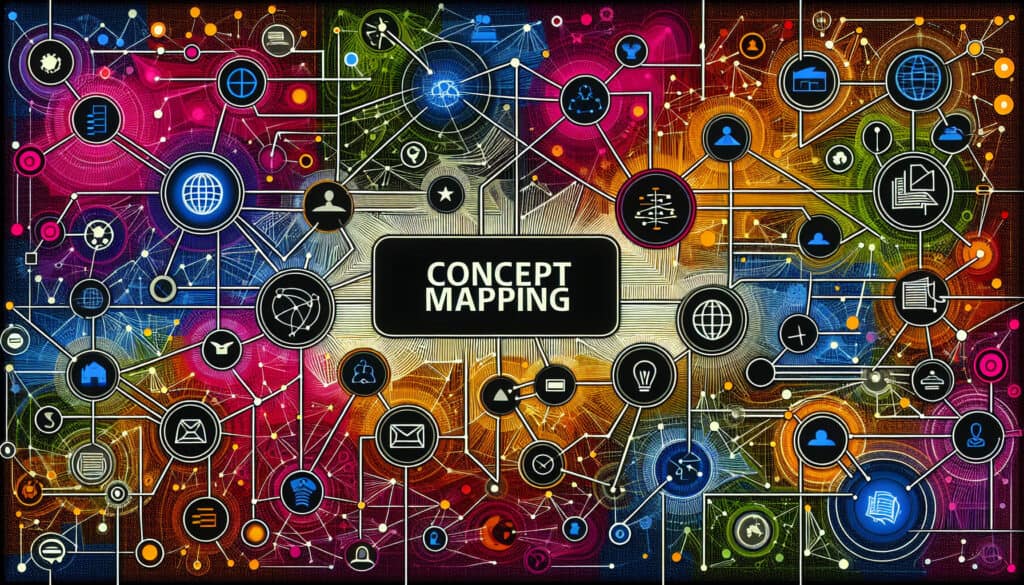A graphical tool for organizing and representing knowledge in the form of a diagram.
- Méthodologies : Clients et marketing, Idéation, Conception de Produits
Concept Mapping

Concept Mapping
- Remue-méninges, Créativité, Pensée conceptuelle, Idéation, Conception d'interaction, Techniques de résolution de problèmes, Langage de modélisation des systèmes (SysML), User-Centered Design
Objectif :
Comment il est utilisé :
- It involves creating a visual map where nodes represent concepts and links represent the relationships between them. It is used for brainstorming, knowledge organization, and problem-solving.
Avantages
- Helps to visualize complex relationships and organize thoughts, promotes creative thinking and problem-solving, and serves as an effective communication and learning tool.
Inconvénients
- Can become cluttered and difficult to read if there are too many concepts, the process can be time-consuming, and the representation can be subjective.
Catégories :
- Idéation, Résolution de problèmes, Conception de Produits
Idéal pour :
- Visually organizing and representing concepts and their relationships to facilitate understanding and idea generation.
Concept Mapping proves valuable across various stages of product development and design, enabling teams to explore interconnected ideas and refine their focus. For instance, during the ideation phase, cross-functional teams can visually represent their thoughts around a new product or solution, enhancing collaborative efforts and preventing information silos. In sectors like healthcare, education, and software development, concept mapping facilitates the identification of user needs, system requirements, and design specifications. Participating in this process typically involves designers, engineers, product managers, and stakeholders who contribute diverse perspectives, enriching the map’s effectiveness. The methodology proves beneficial in workshops and brainstorming sessions, where participants can dynamically adapt the map as new ideas arise, ensuring that no significant concepts are overlooked. By using codage couleur and various shapes, teams can prioritize elements and elucidate relationships between aspects, making discussions more productive and focused. This visual representation serves not just as a tool for problem-solving but also as a foundation for creating documentation, training materials, and roadmaps, ensuring that all participants maintain a unified vision throughout the project’s lifecycle.
Principales étapes de cette méthodologie
- Identify the central concept or problem to address.
- Brainstorm related concepts that connect to the central idea.
- Organize concepts hierarchically to reflect relationships.
- Create nodes for each identified concept.
- Establish links between nodes to denote relationships.
- Refine the map by adjusting concepts and connections for clarity.
- Utilize colors or symbols to differentiate types of relationships.
- Iterate on the map by inviting feedback and revising according to new insights.
Conseils de pro
- Incorporate cross-disciplinary perspectives to enrich the mapping process and uncover novel relationships among concepts.
- Regularly revisit and revise maps as new information emerges, ensuring they reflect the evolving nature of projects and ideas.
- Utilize concept mapping software with collaborative features, enabling real-time input and fostering diverse viewpoints within teams.
Lire et comparer plusieurs méthodologies, nous recommandons le
> Référentiel méthodologique étendu <
ainsi que plus de 400 autres méthodologies.
Vos commentaires sur cette méthodologie ou des informations supplémentaires sont les bienvenus sur le site web de la Commission européenne. section des commentaires ci-dessous ↓ , ainsi que toute idée ou lien en rapport avec l'ingénierie.
Contexte historique
1828
1850
1854
1854
1911
1928
1950
1827
1848
1850
1854
1895
1914
1943
1970
(si la date est inconnue ou n'est pas pertinente, par exemple "mécanique des fluides", une estimation arrondie de son émergence notable est fournie)















Articles Similaires
Gestion des opérations de fabrication (MOM)
Système d'exécution de la fabrication (MES)
Plan de contrôle de la fabrication
Tests manuels
Tableaux d'évaluation des manutentions manuelles (MAC)
ManTRA (outil d'évaluation des risques liés aux tâches manuelles)